
On page optimisation
A few years ago, the administrator of a Facebook group called Secret Kitchen and Travel (secretkitchenandtravel.gr), a group with several thousand members whose interest was focused on travel and cooking, contacted me via email.
Although the purpose of the communication was for me to offer (as the manager of the small family accommodation business in Arachova) a gift for a contest that the group would hold, it ended up in a collaboration that still continues today.
Seeing how much energy the administrators of this group put into creating and promoting useful content on the internet, I asked the owner and main administrator of the group why they don’t create their own space, a website.
The administrator herself, a chef, had little contact and experience with internet technologies and wondered, as expected, what the point of doing this would be?
Facebook covered the communication needs fine, it was familiar to use, and almost everyone has an account there and can find it.
The question I asked her was simple.
What is your goal regarding this group?
Having gathered, from what she told me, a lot of material from her work as a chef and great passion for it, she had created this group.
Along the way, she realized that if she wanted to gain some—even small—financial benefit from the effort, she would have to create a website, which worried her because that would require an accountant, dealings with the tax office, etc.
Although I did not share her financial concerns, I did not delve into that topic but answered her very simply: what happens if one day Facebook decides the group does not meet its terms of service and shuts down the group?
Or what if Facebook itself doesn’t do well and shuts down?
Or if a better platform comes out and people leave and go there? Wouldn’t it be better to have her visitors in a space she owns?
Groups and pages on Facebook belong to Facebook, the same applies to all other platforms, hence the role as “Administrator” for those responsible for groups like Secret Kitchen and Travel.
I also added that by having her own space, how she would monetize it, that is how she would generate income and have profits that would compensate somewhat for the time and energy she invests, would be something she could figure out along the way.
Because I liked the work being done in this group and the enthusiasm I saw in the administrator, I offered to help her get started, since it wasn’t difficult for me to set up a simple site with content management, I was already paying for a very good and fast server and wanted to see how it could go.
So, we created secretkitchenandtravel.gr.
Image 6.1: Secret Kitchen and Travel site homepage.
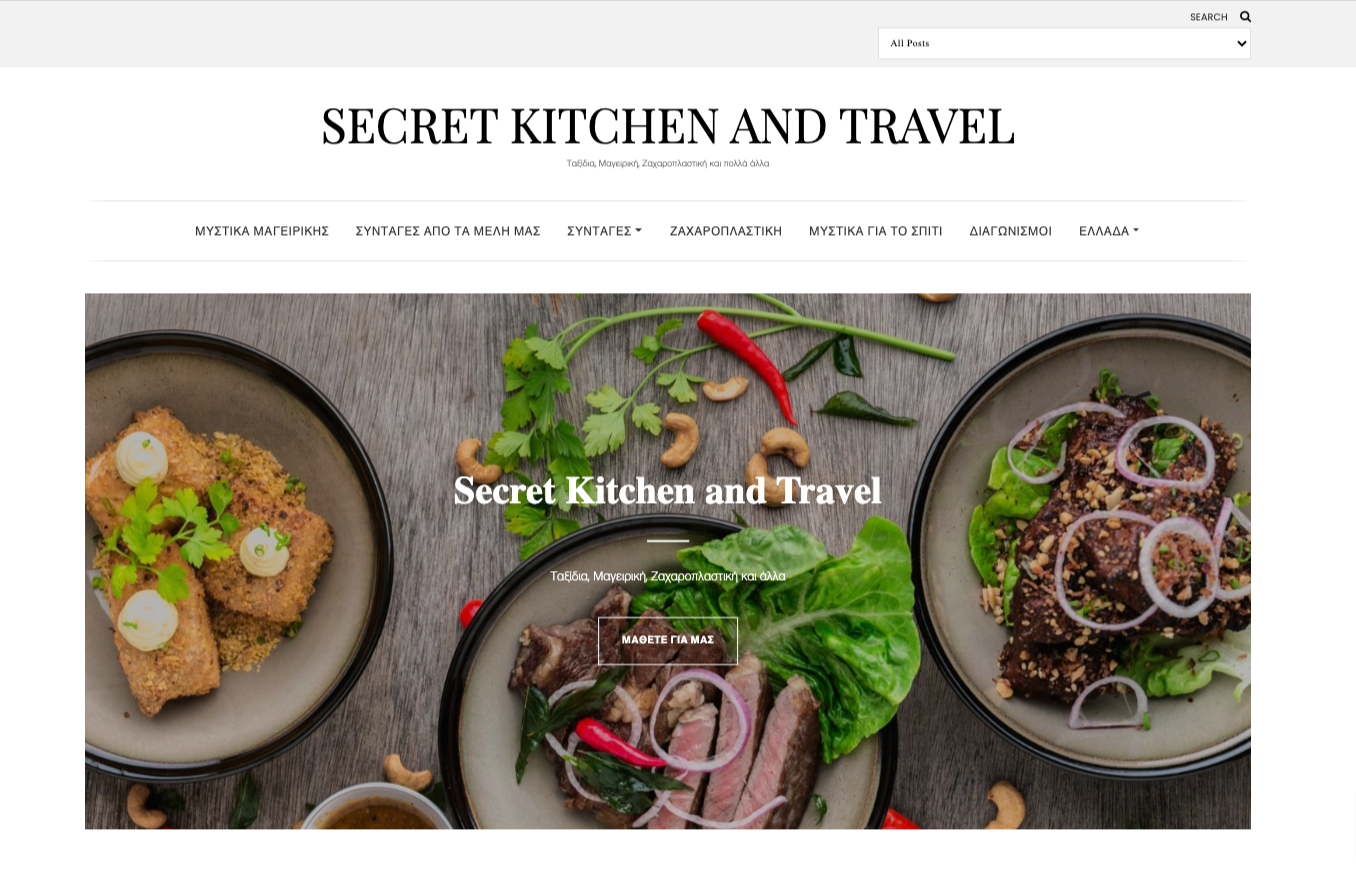
Although today this site has many hundreds of pages and traffic of many thousands of visitors per month, I believe it hasn’t yet reached its full potential for one main reason: On page optimisation.
That is, its pages do not contain all the necessary elements, structure, length, internal links between site pages, titles, descriptions, etc., to rocket up search engine results.
Although we made efforts with the administrator for training on this topic, I believe both I and she didn’t put in the energy needed to make Secret Kitchen and Travel one of the biggest sites in this field.
And it could have.
This chapter contains all the basic elements I should have told her, and she should have read and applied, and then Secret Kitchen and Travel would have taken off.
This chapter covers the basic principles a page on the internet should have in order to be considered high quality by search engines and users and to fully exploit its content and its search engine results.
On Page SEO, or on-page optimisation for search engines, is a set of practices by which a page’s content has the optimal structure, length and coding (html) so it is clear to search engines what it is about and what information it contains.
In simple terms, as search engine bots scan pages on the internet trying to decode the content and subject of those pages, On Page SEO is structuring pages in such a way as to assist this decoding and analysis that will rank them in quality higher than other pages with similar content but worse structure.
For each content element of a page on the internet, whether text in a paragraph, a title, a section header, a list, an image or a video, there is coding in machine language.
Each element, so the machine understands it and the browser displays it correctly, is enclosed in specific tags; for example a paragraph is <p>Text!</p>, where “Text!” is enclosed by the “p” tag, meaning paragraph.
Unfortunately, however, the use of tags (html language) is not optimally utilized by most content producers on the internet and often happens without content creators realizing it due to using content management tools friendly to humans and not machines.
Thus two pages with similar content may use completely different tag structures and one may be rated by machines as mediocre or bad while the other as very high quality and valuable.
Besides tag usage, other elements similarly are more understandable to machines, which also appreciate the use of images, videos, titles and proper paragraphing, internal and external links, etc., for many reasons including user experience.
The most important components of a good page are the following.
Title
The best content creators and page creators on the internet know the power of a good page title.
Conversely, recently the phenomenon of clickbait is common and annoying, using titles that attract user interest and ultimately get clicks but do not meet reader expectations (mainly words and expressions like “Shocking”, “You won’t believe it”, “Mourning for so-and-so actor”, etc.).
A page’s title is very important as it appears in browser tabs (fig. 6.2) and most importantly in search engine results (fig. 6.3).
Image 6.2: Page titles in Chrome tabs (source: semrush.com).
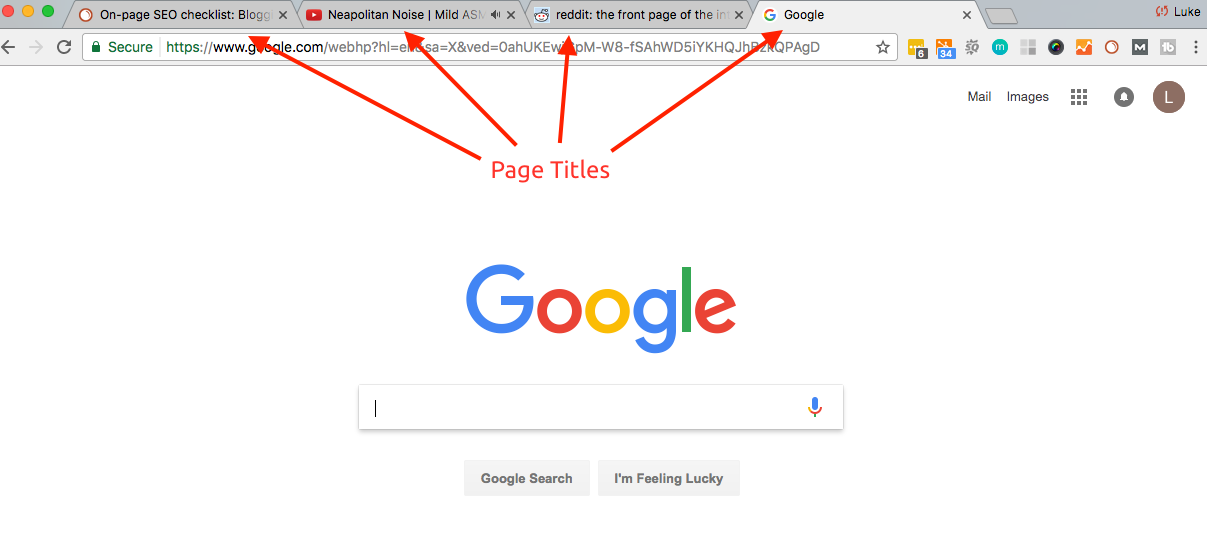
Image 6.3: Page titles in Google Search results.
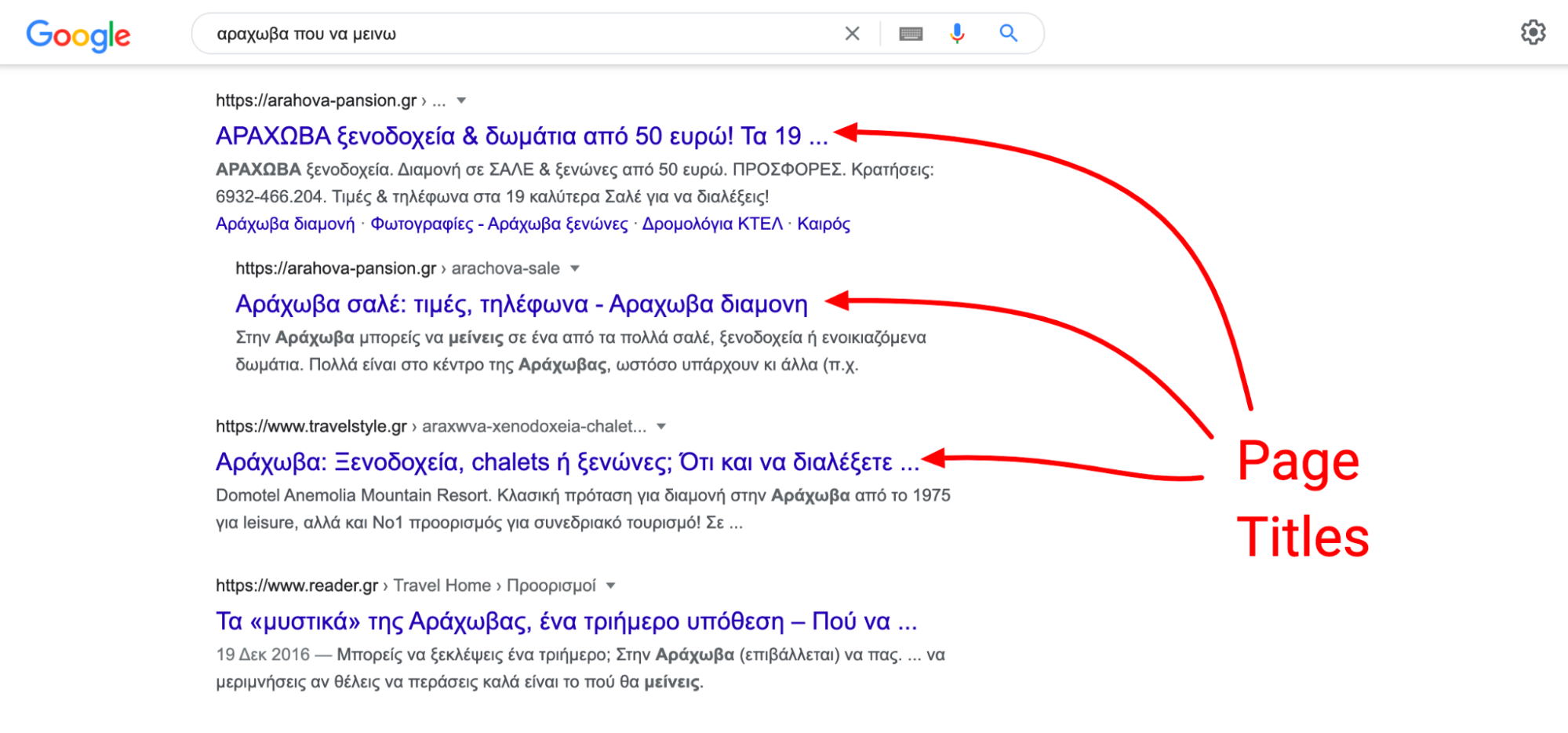
Almost a whole industry exists around title creation and performance, as if a title isn’t descriptive and doesn’t reflect page content, users probably won’t select it and won’t visit the page.
On the other hand, if a title is very attractive but the content doesn’t correspond to it, i.e., it’s clickbait, it annoys visitors; no one wants to waste time on deception.
So a page’s title is one of its most important elements and directly and greatly affects the click-through rate (CTR), i.e., how many click it from those who see it.
It’s also the first impression potential visitors have with the site and the page; a bad impression would be harmful.
Writing a page’s title is also important because on one hand it should meet search engine specs and on the other be descriptive and human-friendly.
Each page’s title should briefly describe what it is about, what it contains, include basic keywords people search for and if possible trigger an emotional reaction.
Though one can read much on title creation, generally 3 simple rules apply: Numbers, simplicity, and magnet words.
Before these, there are 3 basic rules on what a good title means for search engines. Every title must follow:
- Length: Title size is limited due to limited space in search results, generally no more than 60-70 characters.
- Keywords: Titles commonly contain one or more main target keywords.
- Uniqueness: Each page should have a unique title.
As said, using numbers and magnet words and simplicity in a title can make a difference.
Magnet words include “how”, “why”, “what”, “where”, “absolute”, “amazing”, “free”, “exciting”, “magical”, “download”, brand names, or the year (e.g., 2022).
On my page Arahova Pansion for Arachova attractions, first in Google results, I wrote: “Arachova Information Attractions: 17 quick tips (video & list)”.
Image 6.4: Title with number and magnet word use at Arahova Pansion.
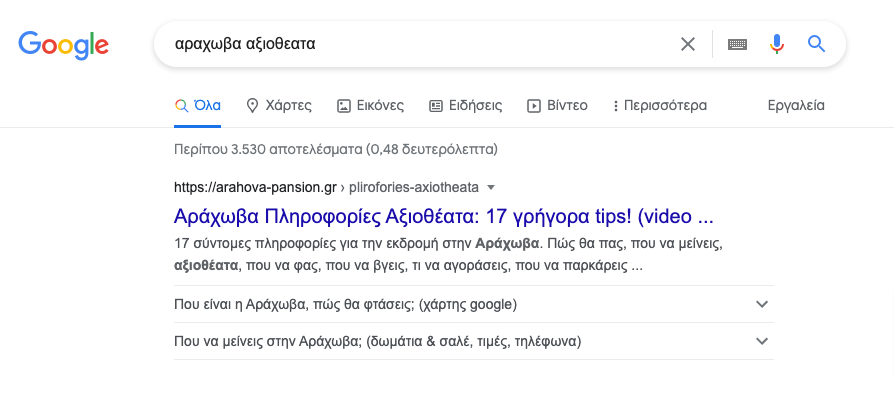
No one writes perfect titles first time, but that’s OK.
Titles can be changed/adapted (Google updates titles in hours or days).
With time and practice, title writing gets better, bringing increased traffic and visits — visitors truly interested in the content.
Description
Meta description is an html element concerning brief description of the page.
It supplements the title and though less important, can help quite a bit with better search ranking.
In Google, meta descriptions appear below the title (fig. 6.5).
Image 6.5: Description at Arahova Pansion.

A good page description helps search engines understand content and lets potential visitors quickly decide if the page contains what they want.
Like titles, there are limits from search engines and best practices for better descriptions.
- Length: Usually no more than 155-160 characters to display fully in results.
- Keywords: Common to include main keywords targeted.
- Uniqueness: Each description is unique per page.
Good descriptions have active voice and encourage action, with words like “See”, “Find”, “What to do”, “How to achieve”, “Buy”, “Book” (Call to Action).
Also good to include some main info or sections of content, e.g. price, availability, user reviews count.
Image 6.6: Product descriptions from Skroutz.gr.
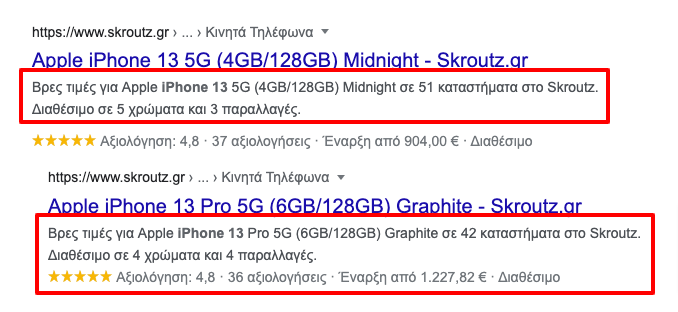
Though before Google took titles/descriptions exclusively from pages, now it sometimes puts what it thinks is better.
Despite that, the importance of good titles and descriptions remains, and every page should have correct, descriptive, clear titles and descriptions.
URL
The URL (Uniform Resource Locator), i.e. the address of each page, is also vital.
In most CMS (e.g., WordPress) the URL is set on creation by the user, should be short, clear and have a consistent structure.
Greek titles decode to non-human-readable forms because Greek characters are non-ascii but valid URI characters, e.g.:
→ https://example.gr/προιον
becomes
→ https://example.gr/%CF%80%CF%81%CE%BF%CE%B9%CE%BF%CE%BD
CMS often transliterate Greek to greeklish automatically, e.g.:
→ https://example.gr/proion
A tip: do not include the year in URLs as addresses are unique and can change, e.g., “best-page-2021” is bad for 2022.
URLs should remain constant or redirect properly to new ones.
Only one URL points to a specific page at a time.
The part after the domain is the slug.
Friendly URLs are short, understandable, words separated by dashes, and contain target keywords.
Google advises URLs to contain words related to site content.
CMS-generated pages sometimes use params like “?page=2” but these are bad for SEO.
Consistent page structure with descriptive folders helps SEO, e.g.
→ https://example.gr/products/product-1.html
→ https://example.gr/services/service-1.html
Image 6.7: URL anatomy (source: ahrefs.com).
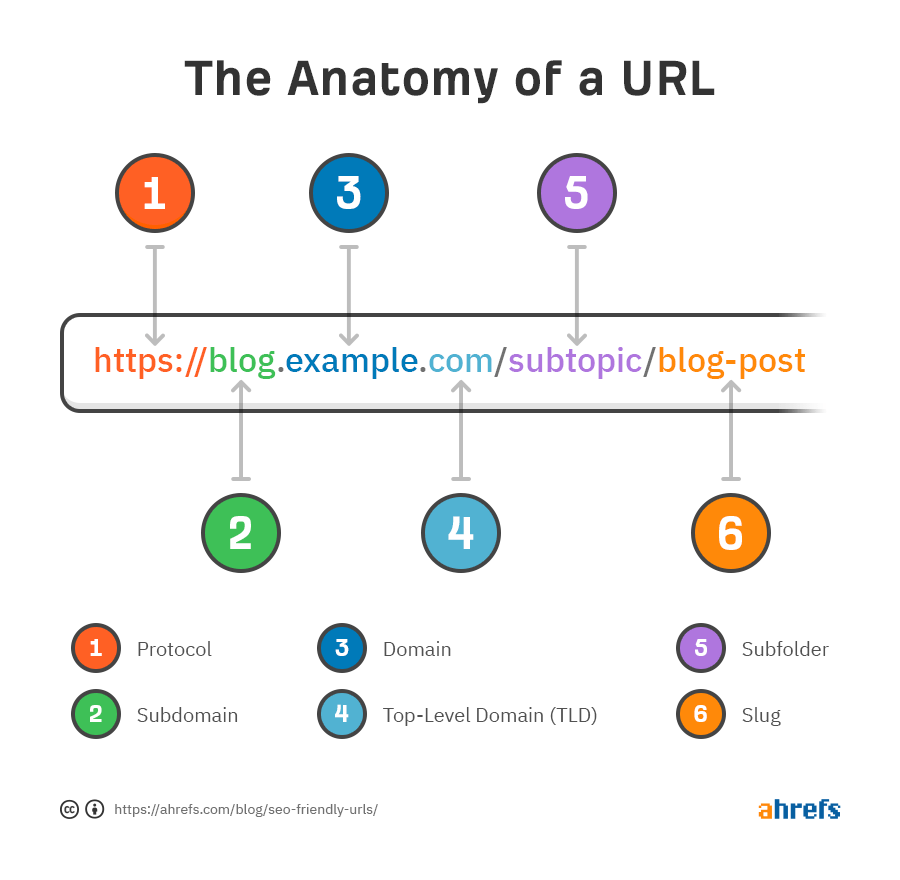
More can be read at https://ahrefs.com/blog/seo-friendly-urls/.
Content
In January 1996, Bill Gates wrote “Content is King” saying content will create most value/money in coming years, like TV did.
TV revolution birthed industries, but winners were those using TV to communicate content for entertainment.
On internet, communication is two-way, users can interact & co-shape content.
Content includes a wide spectrum anyone can produce, even with a cheap computer/smartphone available globally.
This magic made me change career to web development.
Having created code and content for popular Greek sites and others, content creation is one of the most important things for business success.
No single rule on how content should be written, structured, length or inclusion.
A page should be broad enough to include all info on a topic, as short as possible to avoid tiring, understandable and simple for humans, structured with titles and sections, multimedia support, links, and functionality to answer visitor questions quickly and clearly.
Some pages are navigational, supporting final answer pages, appear less in search.
Final pages with real value attract visitors and convert them.
Good content pages often include many synonyms, human-like flow, short sentences, and unique functions.
Years ago, creating a site for Energy Certificate services, I saw cost was a frequent query but poorly answered online.
Issuance cost is often avoided due to expected resistance, hoping for direct communication.
So, a calculator was made showing cost and discount so visitors know in advance what they’d pay (fig. 6.8).
A short video explained getting quick estimates and offers by filling form with property type & size.
A call-to-action button led to company’s secretariat via phone for certificate assignment.
The page was promoted with posts on certifications, requirements, laws.
It held 1st rank in Google for related queries and many assigned certificates via it, helping company success.
Content was brief legislation info, simple video, form & call button opening phone app with price offer.
Impressive, right?
Image 6.8: Energy Certificate price calculator at Energiakoi.com.
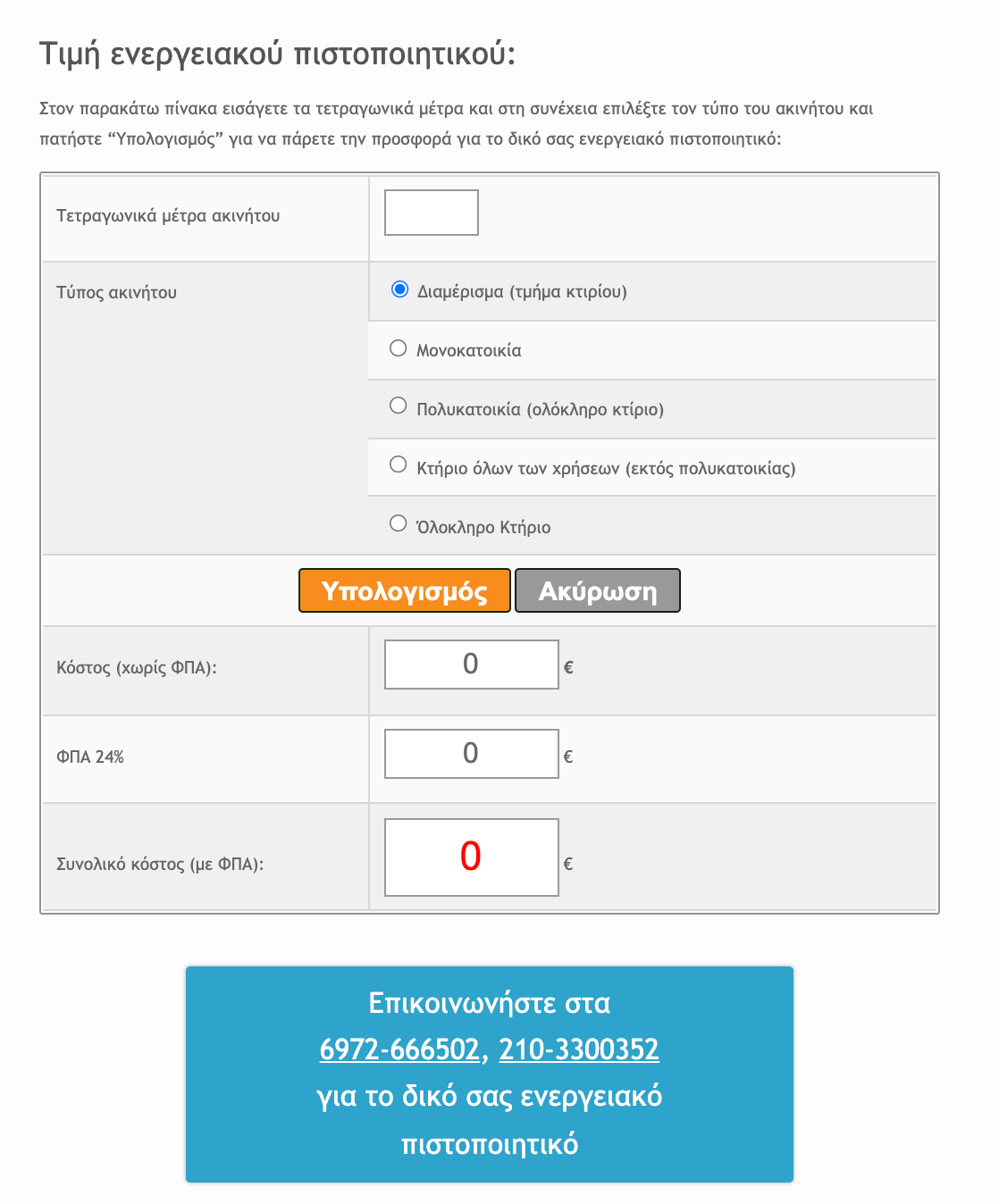
Another interesting content case was Arahova Pansion website competing with Booking, TripAdvisor, Airbnb…
Goal: attract visitors to book accommodation in Arachova, hard competing against global giants who advertise a lot.
Image 6.9: Booking.com Google ad for “arachova accommodation”.
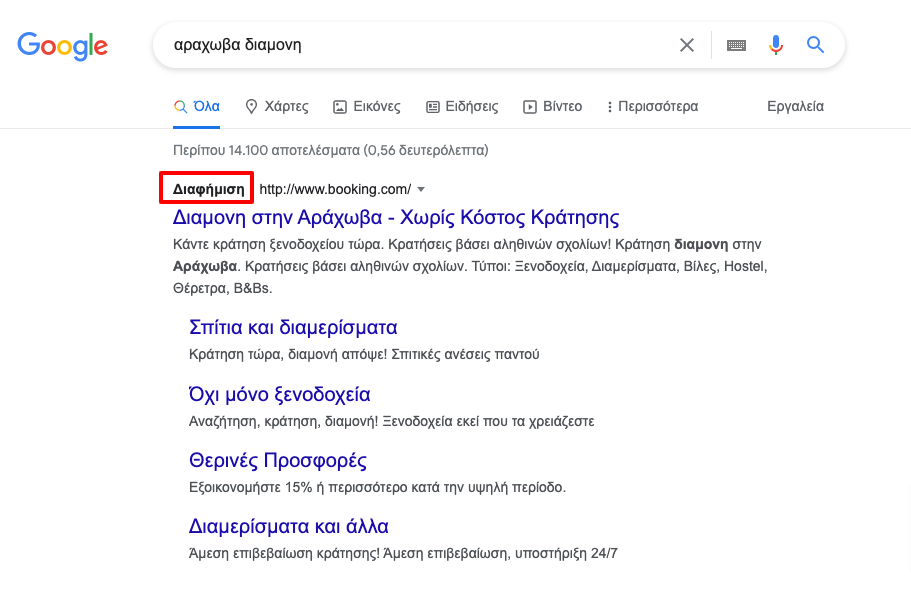
So, I searched for what these sites lack that users need.
E.g., businesses on peak days often avoid listing rooms on Booking/Airbnb to avoid commission.
Users want direct contact, better prices, quick info on business strengths.
Many calls asked: is accommodation in Arachova center?
I focused exactly on that, creating a page with 19 Arachova accommodations, categorized by location.
For each (Arahova Pansion first), I read all Booking reviews to highlight key features.
Created cards with representative image, distinguishing features, average price, and links to phone contact and Booking.
Image 6.10: Accommodation cards at Arahova-Pansion.gr.
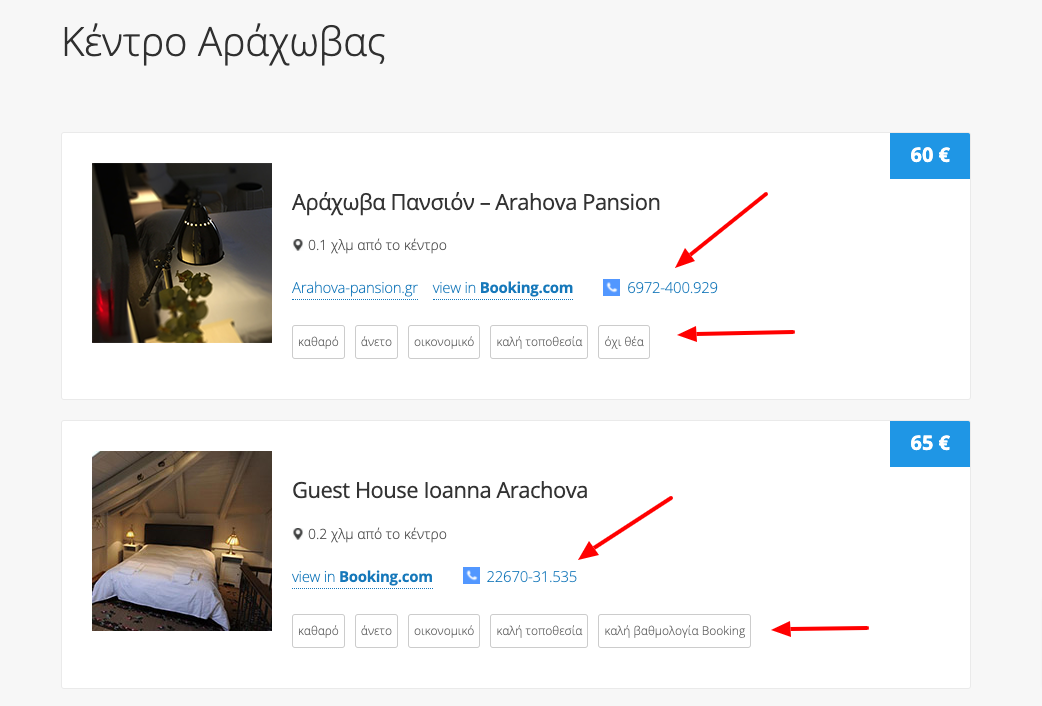
The page linked to other Arahova Pansion pages and quickly appeared in Google.
Soon it outranked large companies for searches like “where to stay in Arachova”.
Image 6.11: Arahova Pansion 1st in search “where to stay in Arachova”.
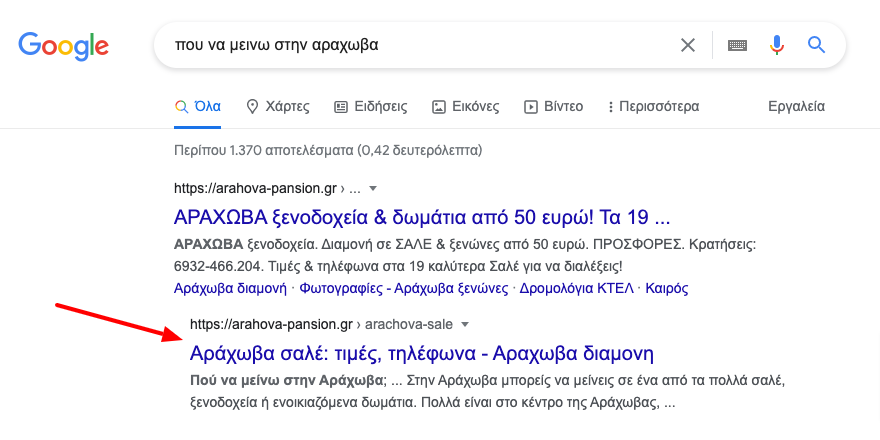
Measurements showed 75% clicks on phone link vs 25% on Booking link, proving visitor desire for direct contact.
I gave visitors value the big companies couldn’t or didn’t want to; users care little about big companies’ business models.
There’s always unexplored paths!
Content options are endless; even small players can add value.
Using simple everyday language, synonyms, logical sections, and good readability, anyone can rank high on Google.
Document outline
Document outline is the content structure of a page.
Page structure separates content into titled sections, tables, forms, etc., helping browsers and machines understand and rank content better.
Look at fig. 6.12 from ama.org—one layout is much easier to read.
Image 6.12: Same content with different formatting/hierarchy (source: ama.org).
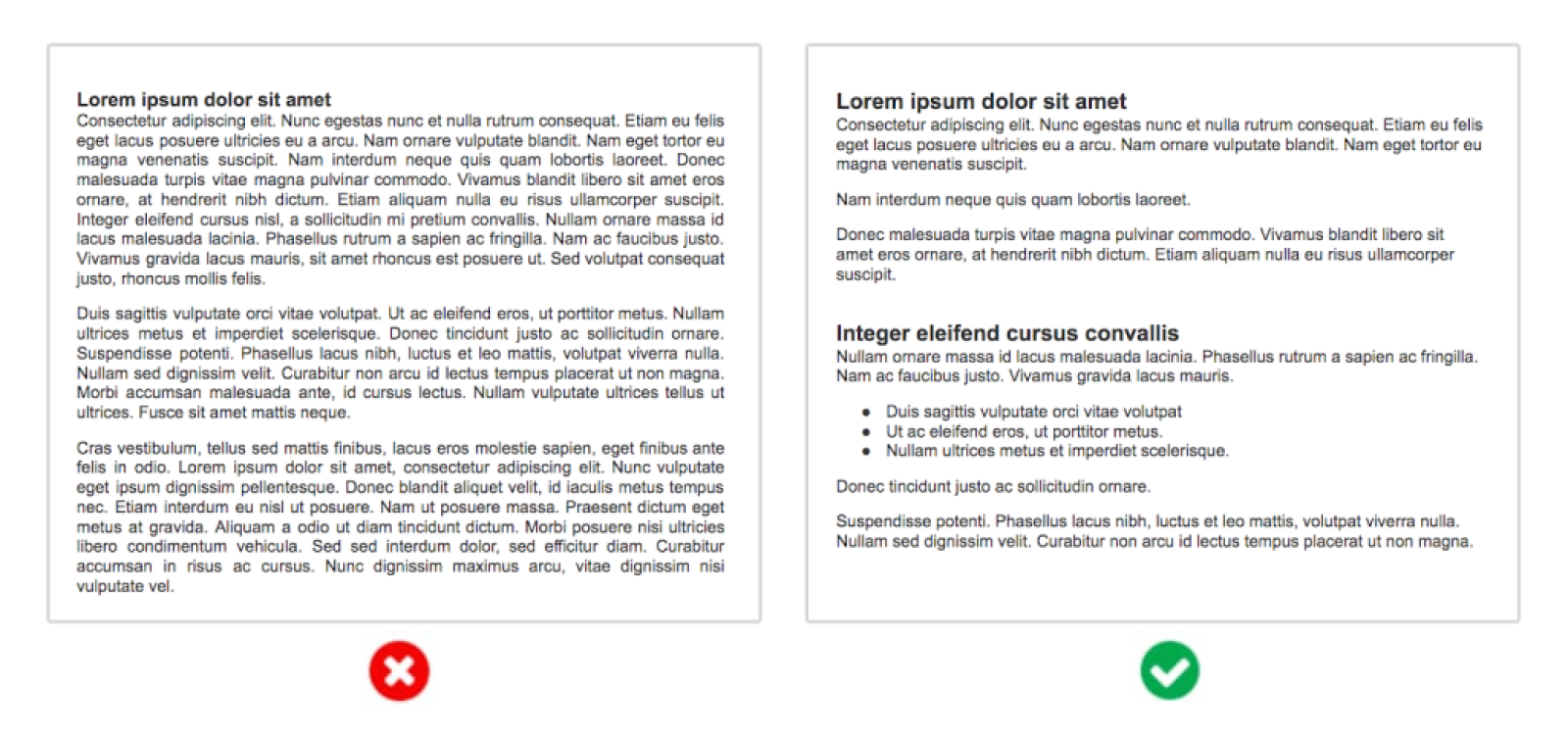
Let’s start from the beginning.
Every web page is an html file. HTML is the main language of web pages; elements are the building blocks.
Google and other machines reading html files assign meaning based on tags enclosing content, e.g., paragraph is <p>Text!</p>.
HTML5 has ~110 tags, including 6 levels of titles: h1 (main), h2, h3, h4, h5, h6.
Having each section with correct level titles and a main h1 is important.
Clear headers ease text separation with hierarchy.
Example of correct heading use:
<h1>Fruits shop</h1>
<p>Text about h1 (fruits and vegetables).</p>
<h2>Tomatoes</h2>
<p>Text about tomatoes.</p>
<h3>Tomatoes no1</h3>
<p>Text about tomatoes no1, a specific kind.</p>
<h3>Tomatoes no2</h3>
<p>Text about tomatoes no1, a specific kind.</p>
<h4>Where can you find tomatoes in City</h4>
<p>Text about info of where user can find and buy tomatoes in the city.</p>
<h2>Cherries</h2>
<p>Text about cherries.</p>
Almost all CMS have special tools for content formatting and structuring, so it is not difficult for someone to apply heading tags. Obviously, one does not need to write their content in HTML code form like the above example.
The image below shows the content formatting toolbar of WordPress (fig. 6.13).
Image 6.13: WordPress formatting and heading application toolbar.
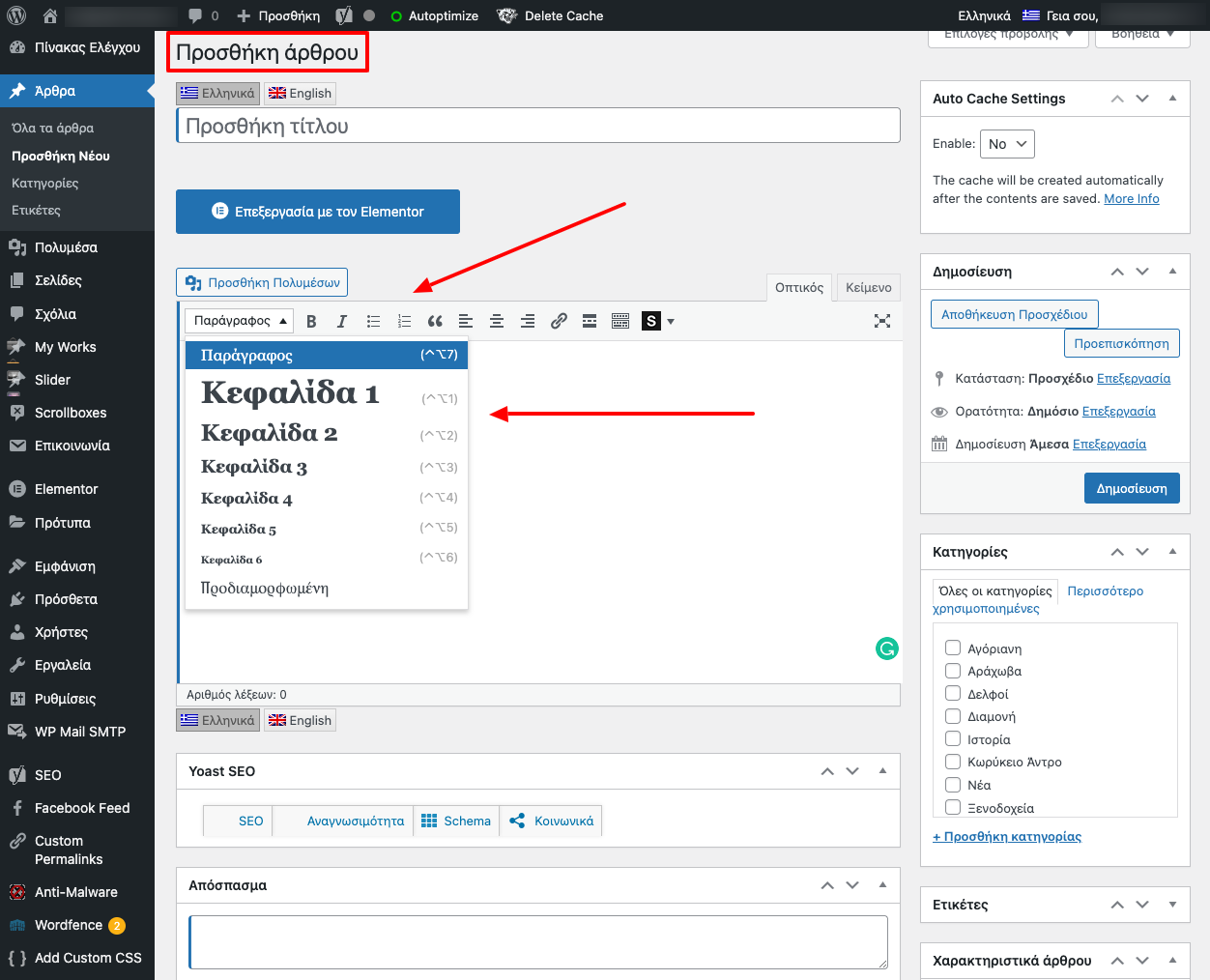
But what is the use of a clear outline with proper titles for each section?
Initially, it is more readable and easier for readers to understand.
A clear structure with titles for each section helps someone scanning the page to quickly find the section of interest, understand what topics the page covers (contents), and ultimately have a very pleasant experience.
On the other hand, Google also places special importance on structure and titles. John Mueller, a Google analyst, stated in 2015 that “we give a slight reward to a page that has clear structure and titles because we can understand better what it refers to.”
It is not mandatory to use all six heading tags; in fact, most pages typically have h1, h2, and h3 headings, while lower-level headings are omitted.
However, h1 and h2 are very important, which is why many consider them signals for better ranking in Google results.
After writing content with structure and appropriate, descriptive titles, one can check and make corrections using suitable tools.
Personally, I use the Web Developer plugin for Chrome (https://chrispederick.com/work/web-developer/) but there are other suggestions, such as HTML5 Outliner (https://github.com/h5o/h5o-chrome). For example, on the Arahova Pansion page with the list of recommended businesses, the document outline is as follows:
Image 6.14: Document outline of the Arahova Pansion page.
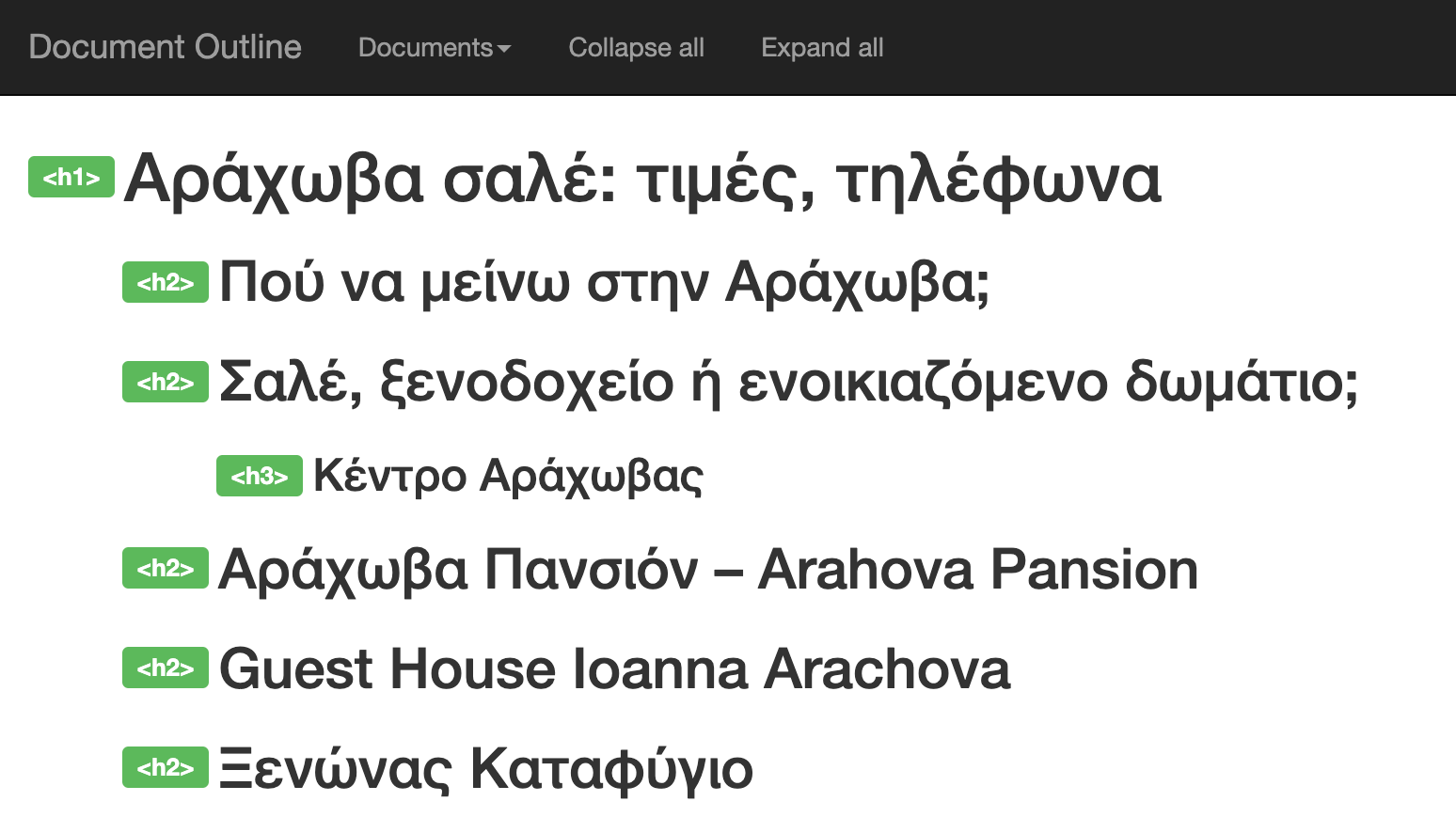
Structuring content into sections and appropriately marking each section with a descriptive short title using an h1-h6 tag is an essential element a good page must have.
Search engines use these titles to quickly scan pages and evaluate how high they should appear in results.
At the same time, the titles make pages digestible and easy to scan quickly by people, which is extremely important as people rarely read all information on a page. This helps them not only to understand what content a page contains but also to read more efficiently.
A good source for more suggestions and good practices around content structuring is backlinko.com/seo-copywriting.
Internal linking
Before a page’s content can achieve good ranking in search engines, it needs links.
Google and other search engines find pages and their content better when they are linked with other, already known pages.
Besides the site’s main navigation menu, which one designs initially for the developer to implement, as well as other fixed links outside the navigation menu (such as the footer), the content should also include useful links to other pages of the same site, so users can follow if they want more information on a topic.
An internal link is any link from one page of a site to another page of the same site.
The other type is external links, directing to pages of other sites, which we also need and are good to have, especially if they lead to pages with useful content and authoritative sites related to a topic.
Through internal links, we provide the relation between pages on a subject and help both readers and search engines better understand this relation.
For many reasons, most of which are technical and beyond the scope here, proper internal linking of pages around a topic is very important.
Image 6.15: Diagram illustrating proper internal linking (source: kevin-indig.com).
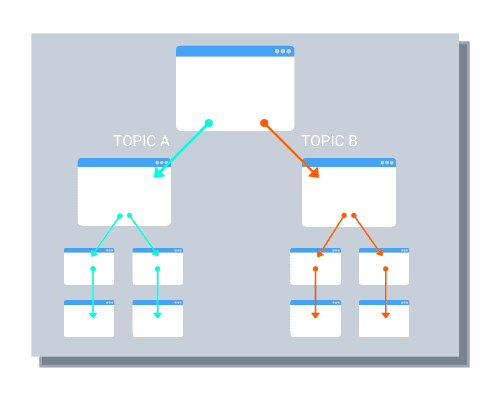
Often, it is appropriate to create several pages related to a topic all linked internally to a main page containing links to all subpages. This is a pillar page and has high chances of success in search results since it is evaluated as a high-quality authoritative page.
Pillar content pages are also useful for visitors as they can find both the overview and individual pages about something they are interested in.
Therefore, for many reasons, each new page created should have appropriate links in the right places to other pages on the same site.
Like other aspects, there’s plenty of information on the internet about the value and how to implement internal linking, such as kevin-indig.com/internal-linking-the-full-guide-to-internal-link-axioms.
Images & Videos
If a picture is worth a thousand words, then a video is worth a thousand images.
This alone conveys the value of using appropriate images and videos that help better understanding and interaction of visitors with a page.
Many studies have examined how people perceive images compared to text.
Many stress that people remember 80% of what they see and only 20% of what they read.
Also, studies show people learn mainly from visual stimuli. MIT, for example, found that the human brain can process images in 13 milliseconds.
Many more statistics support that images are a powerful communication medium.
Most importantly, images remove language barriers: an image is understood worldwide regardless of language spoken.
On the internet, images are used for all sorts of reasons: to enhance site presence, visualize stories and data, in ads, to showcase products or services, etc.
Simultaneously, social media giant growth was driven by image and video use (Instagram, TikTok), and they rank high among the world’s most successful companies.
Around 3.2 billion images and 720,000 hours of video are shared daily online (2020), per sciencedaily.com.
Also, Generation Y (born 1981-1996) prefers image-based communication over text-based, an important fact as they will soon become the most significant consumer segment, surpassing baby boomers and Generation X.
Today, amid info overload, images gain special importance: social media expert Jeff Bullas states “67% of consumers say product image quality is ‘very important’ to their product choice and purchase on ecommerce sites. Even more important than product info (63%), a long description (54%), and reviews (53%).”
Let’s look at how appropriate images help a page/site.
First, images and videos attract visitor attention. Visual media can convey multiple messages instantly.
For example, a hotel site visitor (like at Arahova Pansion) can see decorations and amenities through images/videos without reading long descriptions.
This improves user experience and conveys a message likely answering visitor questions to proceed with booking.
Another point: using images and videos increases dwell time on a page.
Dwell time is a signal to Google and other search engines of quality and influences better search ranking.
Engines like Google reward visitor engagement with higher rankings.
Images and videos should be an integral part of any website content strategy.
Best images/videos should be placed high on the page, aesthetically and informatively functional, directly related to page text, and ideally original.
Also, good and original images/videos can themselves bring traffic as they appear in Google image/video results.
Here are two examples of images I used to attract visitor interest to Arahova Pansion.
The first refers to events for Saint George’s festival in Arachova, a three-day religious festival in early spring.
At that time many locals dress daily in traditional Central Greek costumes and there is a magical atmosphere with many events unforgettable to outsiders.
At the same time, the Parnassos ski center, visited by many in Arachova, is often still open (end of winter season).
To communicate that Arachova is worth visiting (and staying at Arahova Pansion) at that specific period, I made an image from the foot of a tsolias (traditional male costume) wearing a ski boot, underneath the slogan “tsarouhi boot”, and announced the days of the famous “Arachova Festival” (fig. 6.16).
Obviously, this requires image editing skills, but with an idea, one can easily hire a freelancer for a small fee (e.g., Fiverr.com, Upwork.com).
Image 6.16: Creative ad image for Arahova Pansion about festival events and ski center.
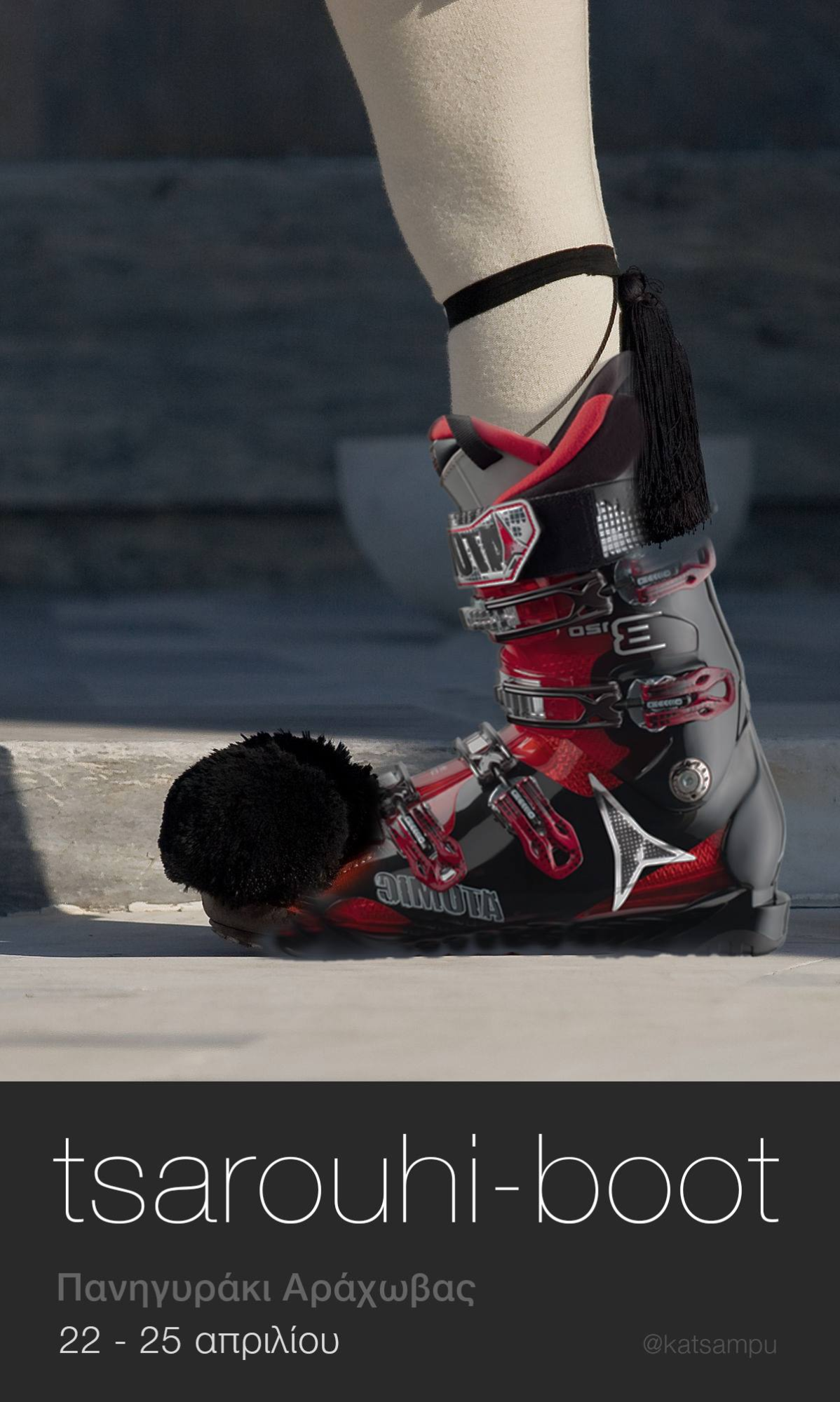
The goal was to spark a reaction like “Wait, what??”, which I believed would translate to visitors remembering to visit Arachova to live these two experiences.
The second example is a post about the Parnassos ski center.
The idea was to depict the new lifts unusually and attract interest with a story (read at https://arahova-pansion.gr/playmobil-parnasso-photos).
As most articles about the renovated ski center were much alike, with photos of new lifts, capacity info, etc., I thought differently when I saw a Playmobil family skiing in a gift shop.
I bought the specific Playmobil, and on my next ski trip (I’m a skier for years with Arachova family roots) I took it with me.
Using only my smartphone, I photographed the Playmobil at appropriate angles with ski center background and wrote a story about pistes, their names, some history, etc.
At page end I wrote:
I had long wanted to create a story involving Playmobil and Parnassos. This story would be accompanied by photos of Playmobil in action at favorite spots in Parnassos, especially the Ski Center where I have been a customer for 31 years skiing in winter and doing other summer sports. Through the story, I wanted to show buyers the mountain beauty, Parnassos, winter tourism and sports. Also, I wanted to present to mountain sports lovers and Parnassos fans the charm of Playmobil. I hope the result achieves this dual purpose somewhat.
Image 6.17: Playmobil photo at Parnassos ski center (Arahova Pansion).
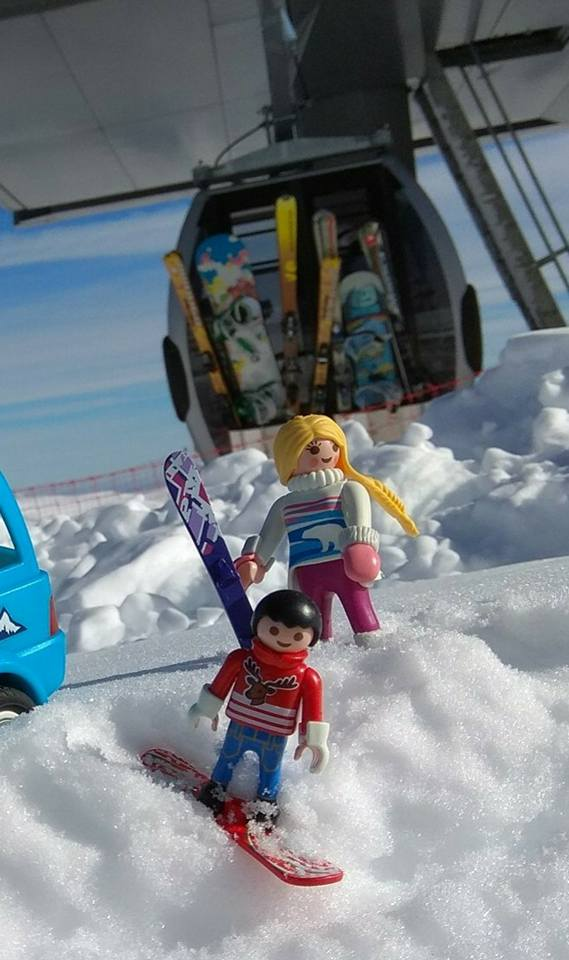
Image 6.18: Playmobil photo at Parnassos ski center (Arahova Pansion).
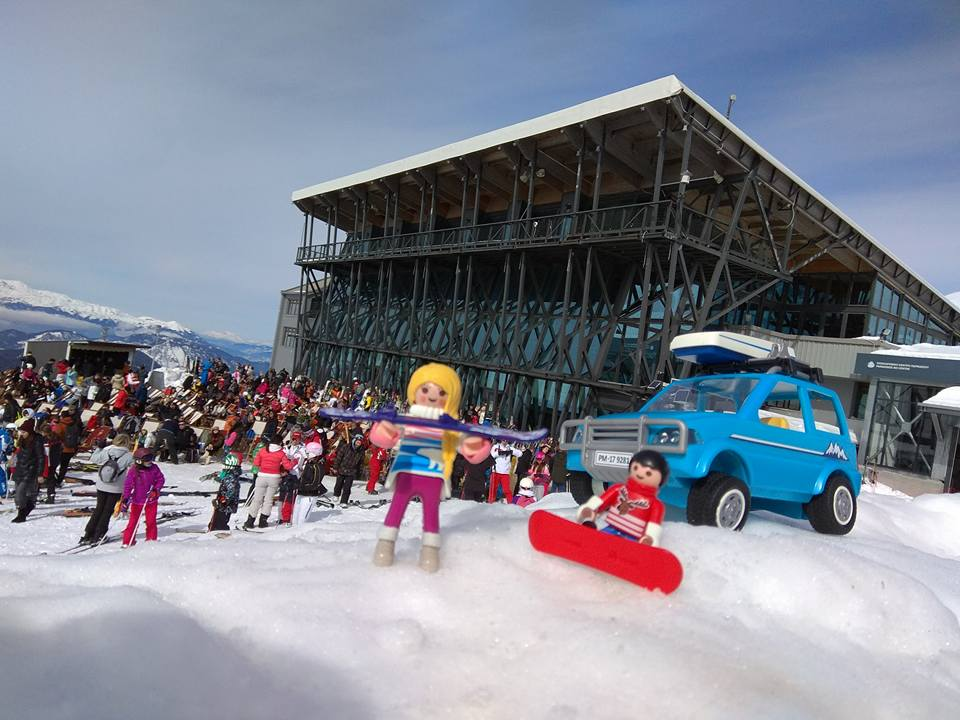
Image 6.19: Playmobil photo at Parnassos ski center (Arahova Pansion).
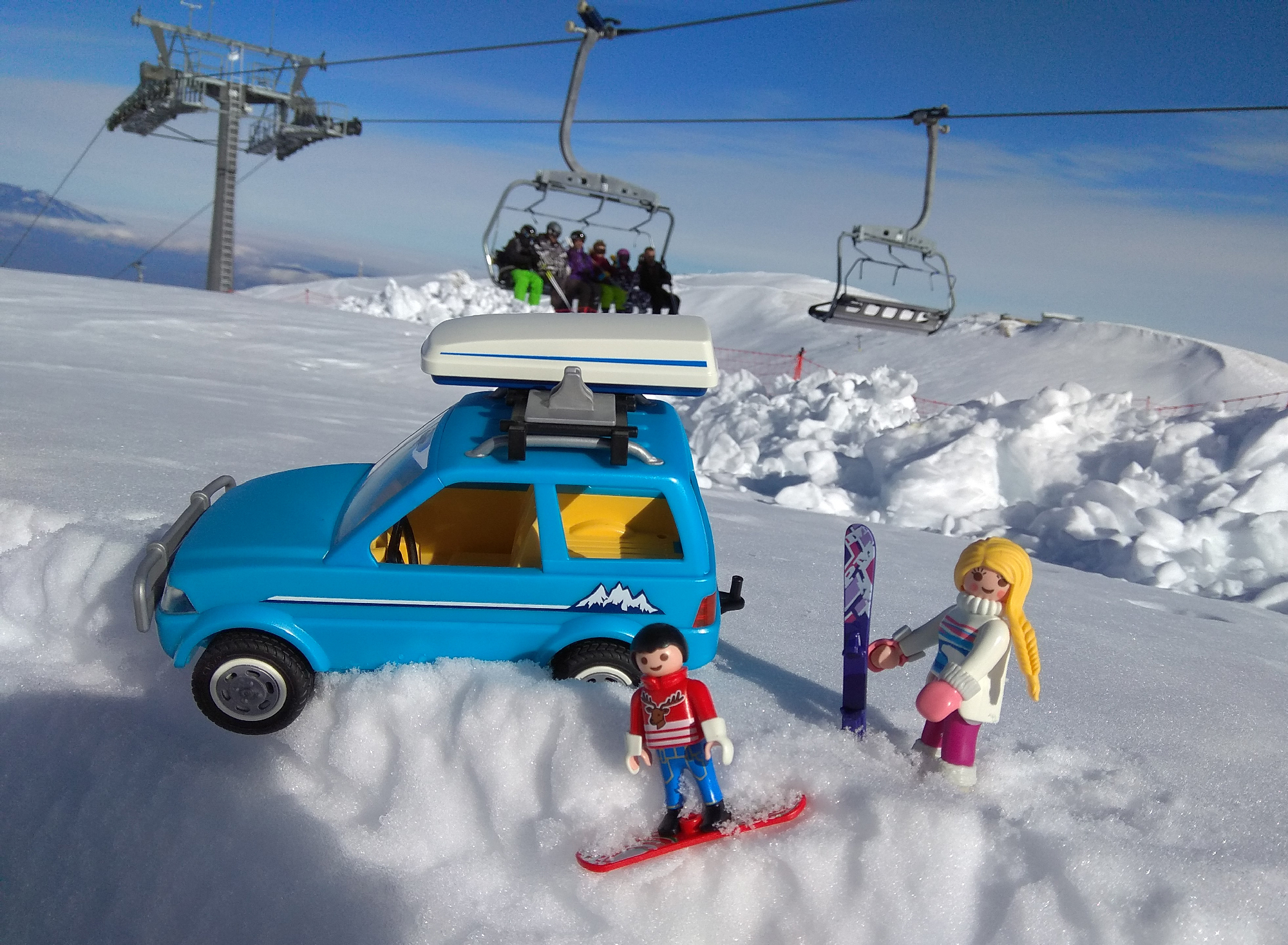
After posting, I shared on social media and many found it clever and interesting.
It was so attractive that Playmobil Hellas, the official Greek Playmobil representative, called me to get permission to publish the story and images on their own pages!
Using my own tools and without following big sites and successful company paths, I managed to win interest and triumph in communicating about the renovated ski center.
If we consider all wars of the last 200 years between a very strong country (e.g., equipment, soldiers, economy) and a far weaker one, how often do you think the stronger wins?
Most would say almost always the stronger wins.
The real answer may surprise you.
Political scientist Ivan Arreguín-Toft calculated that about 3 times in 10 the weaker wins.
But if the weaker fights unconventionally, refusing to fight in the stronger’s way, it wins more than 6 times in 10.
An example: in a war between Turkey and Greece (Turkey 8x population, much bigger economy and military), if Greece fought unconventionally, history suggests one should bet on Greece.
A famous example is T.E. Lawrence, aka Lawrence of Arabia.
Lawrence, a British archaeologist, led the Arab revolt against the Ottoman army at the end of WWI.
Turks had a formidable modern army. Lawrence, in contrast, had an undisciplined band of Bedouins, simply nomads. One British commander called them “an untrained rabble, most never having fired a rifle.”
Yet Bedouins were tough and constantly on the move. Lawrence’s soldiers carried only a rifle, 100 rounds and 45 lbs of flour, enabling travel of 110 miles a day across the desert, even in summer. They carried little water but were good at finding it.
“Our cards were speed and time, not firepower,” wrote Lawrence. “Our greatest weapon was the tribal men, unused to formal war, whose advantages were constant movement, endurance, individual cleverness, knowledge of the land and courage.”
In summer 1917 at the strategic port of Aqaba, Turks awaited attack from British ships from the west.
Lawrence attacked from the east, coming through unguarded desert, leading men on a daring 600-mile journey from Hejaz, north to Syrian desert.
It was one of the most inhospitable places in the Middle East.
They took Aqaba capturing or killing hundreds of heavily armed Turks who never expected attack from the desert.
Though Turks had many soldiers and weapons, this made them immobile and defensive.
Meanwhile Lawrence’s men’s movement, endurance, wits and knowledge enabled the impossible: attacking from the east — a bold strategy Turks never foresaw.
Many advantages come with many material resources (developers, researchers, ad budgets), but some come from lack of resources.
That’s why underdogs often win.
This lesson is hard to learn.
Still, there are opportunities to prevail using speed, knowledge and cleverness even without big means.
Underdogs often win.
Why do we then get shocked when David beats Goliath?
Because we assume a smaller or poorer or less skilled person must be at a disadvantage?
Takeaways:
- Help visitors and machines understand information structure, even if you don’t know coding. CMS makes it simple and easy.
- Practice and improve creating titles and descriptions that appeal to visitors and machines.
- Content is the strongest weapon against internet giants. Create useful content and exploit lack of resources to gain online authority.
Cover image source: Unsplash.com